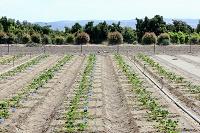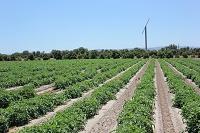Row Crops
Berries
59 - Strawberry Breeding
Principal Investigator: Dr. Doug Shaw, Department of Plant Sciences, University of California – Davis. For more project information, click here.

60- Strawberry Culture
Principal Investigator: Dr. Kirk Larson, Pomologist, UC Cooperative Extension. For more project information, click here.
California produces about 89% of the U.S. strawberry crop on less than 50% of the nation’s strawberry acreage, and California strawberries have an annual farm gate value of over 2 billion dollars. The competitive position currently held by California strawberry growers can be traced to the use of innovative production systems that maximize yield, fruit quality, and harvest efficiency, and the use of cultivars that have broad environmental adaptation and that are characterized by high yields, continuous production over long periods and superior fruit quality. However, markets and production environments are not static: currently, the California strawberry industry faces the combined challenges of an increasingly competitive market, sharp rises in production and material costs, increased labor costs, increasingly scarce and expensive land and water resources, and an increasingly stringent regulatory environment. California producers must overcome market and production cost barriers while facing either a net decrease in the quality of the production environment or increased production costs. Modifications to existing production technologies and the development of new production management technologies and techniques are essential for the continued health of the California strawberry industry. The Integrated Strawberry Production Research Project, located at the UC South Coast REC since 1956, has been a major source of new production technologies that have contributed to the continued strength and expansion of the California strawberry industry.
Nematode Management
129 - Sugar Beet Cyst Nematode
Principal Investigator: Dr. J. Ole Becker, Department of Nematology, University of California – Riverside. For more project information, click here.
For the past 50 years populations of plant-parasitic nematodes have been mainly managed by soil nematicides or fumigants. Environmental concerns have restricted or prohibited the use of these chemicals. Furthermore, economic restrictions and poor general public acceptance of fumigants and nematicides make alternative control measures necessary. One of our approaches is to identifying nematode-deleterious microorganisms and to understand their mode-of-action. We have focused our studies on soils that are suppressive against the beet cyst nematode, Heterodera schachtii. Nematode- suppressive soils are typically characterized by a relatively low population density of a particular plant- parasitic nematode and the inability of the population to increase despite the presence of a susceptible host and suitable environmental conditions. Media-dependent and independent methods will be used to identify the most likely candidates for causing the soil suppression. It is the first step towards understanding the unique combinations of abiotic and biotic soil parameters that lead to nematode population suppressiveness. Further progress should lead to the development of new and more effective pest management strategies. In addition we are exploring biorational approaches to support biocontrol agents. The future of managing plant parasitic nematode is not likely a singular strategy but a multifaceted approach.
Vegetables
58 - IPM in Vegetable Crops
Principal Investigator: Dr. John Trumble, Department of Entomology, University of California – Riverside. For more project information, click here.

82 – Bean Genetics
Principal Investigator: Dr. Giles Waines, Department of Botany & Plant Sciences, University of California – Riverside. For more project information, click here.
Common bean is an important grain legume in California. We know little about genetic control of pollination biology. We treat it as an in-breeder, but common bean may outcross substantially in favorable environmental conditions and with pollinators present. Common bean generally has low seed yield, which suggests it may suffer from inbreeding depression. Research at the UC ANR South Coast Research and Extension Center and UC Riverside indicated bumble bees will transfer pollen from male fertile to male sterile plants, thereby generating F1 hybrid seed. Honey bees transfer pollen less efficiently. Heterosis in common bean seed yield in F1 hybrid plants may be 150%, which makes finding an economic way to produce F1 hybrid seed in the field important.
200 - USDA Interregional Project 4, Row Crops
Principal Investigator: Dr. Peggy Mauk, Botany and Plant Sciences Department, University of California – Riverside. For more project information, click here.
The purpose of this project is to conduct pesticide residue trials with the goal of securing registration of additional agrochemicals for use on minor crops through the USDA Interregional Project 4 (IR-4). IR-4 is a publicly and privately funded USDA program that conducts research and submits petitions to the Environmental Protection Agency (EPA) for registration of pest control agents on specialty crops including most row crops. Since 2003 the UCR IR-4 Center has conducted 27 trials in row crops at SCREC, testing 24 different pesticides.

